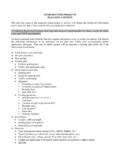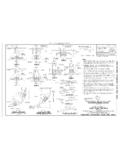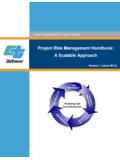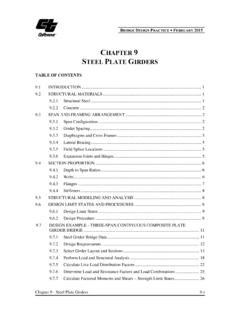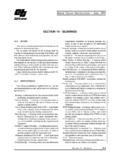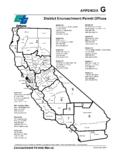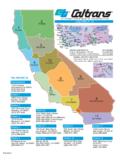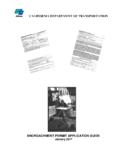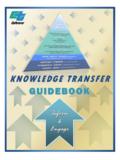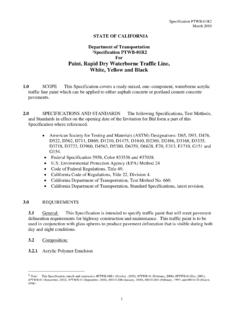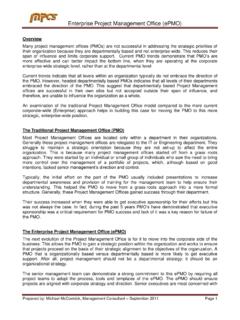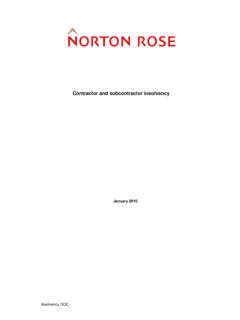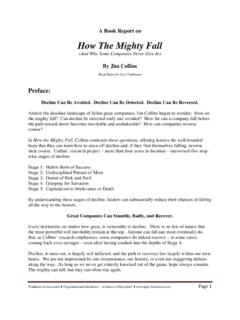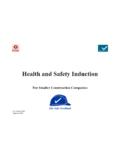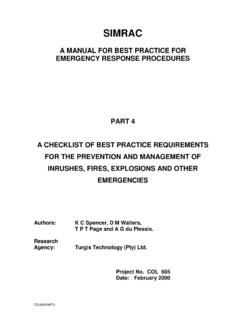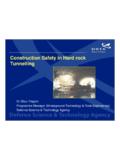Transcription of Chapter 8 Slurry Seals - Caltrans
1 Chapter 8 Slurry TechnicalAdvisory Guide (MTAG)Managers TechnicalAdvisory Guide (MTAG) Slurry SealszWhat are Slurry Seals ?zWhy use Slurry Seals ?zWhere to use Slurry Seals ?zWhen to use Slurry Seals ? Chapter 8 Slurry SealsWhat is Slurry seal ?zA thin maintenance treatmentzA mixture of: asphalt emulsion graded aggregates mineral filler water AdditiveszWhen placed on the pavement surface the mixture breaks and cures creating a new wearing 8 Slurry SealsWhy Use Slurry Seals ?zCost EffectivezBenefits: minimize oxidation/ageing reduce water infiltration provide skid resistance improve aesthetics correct raveling and weatheringzAverage performance life: 3 to 5 yearsChapter 8 Slurry SealsWhere to Use?zHot Mix Asphalt Pavements: Roadways (All traffic levels) Parking Lots Taxiways and Runways Bridges and Over-CrossingszGeographic Regions/Climate Zones: All throughout CaliforniaCape seal ( Slurry over Chip seal ) Chapter 8 Slurry SealsWhen to Use?
2 ZTo correct/improve: raveling and weathering loss of frictional properties aestheticszTo prevent/reduce: ageing/oxidation of asphalt concrete surface water infiltration pavement degradation due to the elementsChapter 8 Slurry SealsWhen NOTto Use?zOn pavements with structuraldefects: Alligator Cracking Rutting Bumps and Depressions PotholeszNighttime constructionChapter 8 Slurry SealsSlurry seal Vs. MicrosurfacingDifferences in:MICROSURFACINGSLURRY SEALA sphalt Emulsionalways polymer modified, quick setcould be polymer modifiedAggregate Quality/Gradationstricter spec. for sand equivalent; use only Type II and Type IIICan use Type I, II or IIIA dditives/Breakchemical break largely independent of weather conditionsbreaking and curing dependent on weather conditionsChapter 8 Slurry SealsSlurry seal Vs. MicrosurfacingDifferences in.
3 MICROSURFACINGSLURRY SEALMix Stiffness/ Equipmentstiffer mix, use augers in the spreader box and secondary strike-offsofter mix, use drag boxApplicationssame as Slurry seal + rut filling, night work, correction of minor surface profile irregularitiescorrect raveling, seal oxidized pavements, restore skid resistanceChapter 8 Slurry SealsModule 8-1 Design, Materials & TechnicalAdvisory Guide (MTAG) Slurry seal DesignzDesign ProcesszSpecificationzMaterialszLaborato ry TestsChapter 8 Slurry SealsMix Design ProcesszPre-screen materialszCheck materials compatibilityzTry different mixing proportionszPrepare mixes at a range of emulsion contentszCheck for cohesion build-upzCheck for abrasion resistancezCheck for sand adhesionzSelect optimum emulsion contentzTest proposed mix to meet specification requirementsSelect/TestSelect/TestMateri alsMaterialsDesign/TestDesign/TestTrial MixesTrial MixesRecommendRecommendMix DesignMix DesignChapter 8 Slurry SealsSpecificationzCaltrans 2006 Standard Specifications, Section 37-2 Slurry seal Slurry Surfacing Association (ISSA): A105 (2005) Recommended Performance Guidelines for Emulsified Asphalt Slurry seal .
4 ASTM D 3910-98(2004) Standard Practices for Design, Testing, and Construction of Slurry seal 8 Slurry SealsMaterialszAsphalt EmulsionzAggregatezMineral FillerzWaterzAdditivesChapter 8 Slurry SealsAsphalt EmulsionzType/Grade Anionic/Quick Set (QS-1h) Cationic/Quick Set (CQS-1h)zSpecification Caltrans 2006 Standard Specifications Section 94zNotes Could be polymer-modified, Caltrans standard specification for PMCQS not available at this timeChapter 8 Slurry SealsAsphalt Emulsion -TestsTests on EmulsionTypical Specification (CQS1h)MethodViscosity, SSF @ 50 C, sec15 90 AASHTO T 59 Sieve Test, %< T 59 Settlement, 5 days, %< 5 ASTM D 244 Storage Stability, 1 day, %< 1 AASHTO T 59 Residue by Distillation, %> 57 California Test 331 Particle ChargePositiveTests on Residue from Distillation TestTypical SpecificationMethodPenetration, 25 C40 90 AASHTO T 49 Ductility, 25 C, mm> 400 AASHTO T 51 Solubility in trichloroethylene, %> 97 AASHTO T 44 Chapter 8 Slurry SealsAggregate -GradationsSieveType IType IIType III3/8 in ( )-100100No.
5 4 ( mm)10094-10070-90No. 8 ( mm)90-10065-9045-70No. 16 ( mm)60-9040-7028-50No. 30 (600- m)40-6525-5019-34No. 200 (75- m)10-205-155-15 Chapter 8 Slurry SealsSlurry Surfacing Systems Aggregate Size (mm)Percent PassingType I MinType I MaxType II MinType II MaxType III MinType III MaxChapter 8 Slurry SealsAggregate -QualityTestType IType IIType IIITest MethodSand Equivalent (min)455560CT 217 Durability Index (min)555555CT 229zOther aspects of interest: Geology Shape Texture Age and Reactivity CleanlinessChapter 8 Slurry SealsMineral FillerzPortland cement, hydrated lime, limestone dust, fly ash or other approved filler meeting the requirements of ASTM D242zConsidered part of the dry aggregatezMixing aid, improves cohesion, absorbs water from the emulsion causing it to break faster after placementChapter 8 Slurry SealsWaterzWater should be of such quality that the asphalt will not separate from the emulsion before the Slurry seal is placed Chapter 8 Slurry SealsAdditiveszEmulsifier solutions, aluminum sulfate, aluminum chloride, boraxzGenerally act as retardants, useful when temperatures rise during the dayChapter 8 Slurry SealsMixing PropertieszISSA TB 102 (Mixing Test)
6 Determine approximate proportions of component materials by trying different recipes The amount of time the Slurry can be mixed and retain its homogenous consistency is recorded (mixing time) Foaming and coating are visually assessed The test can be performed at expected field humidity and temperature conditions Select the proportions that results in mixing times over 180 seconds and good coating over the range of humidity and temperature condition expected at placementChapter 8 Slurry SealsCohesion Build-UpzISSA TB 139 (Modified Cohesion Test)zFabricate 3 test selected emulsion emulsion content3.+2% emulsion contentzDetermine the build-up of cohesion with timezDifferentiate between Quick Set and Slow Set ; Quick Traffic and Slow Traffic mixesChapter 8 Slurry SealsCohesion Build-UpChapter 8 Slurry SealsAbrasion LosszISSA TB 100 (Wet Track Abrasion Test)zFabricate 3 test selected emulsion emulsion content3.
7 +2% emulsion contentzCure specimens for 16 hrs, than soak for 1 hrzDetermine abrasion loss under waterzPlot abrasion loss versus emulsion contentChapter 8 Slurry SealsSand AdhesionzFabricate 3 test selected emulsion emulsion content3.+2% emulsion contentzISSA TB 109 (Loaded Wheel Test) Measure increase in weight of the specimen due to sand adhesion Plot sand adhesion versus emulsion contentChapter 8 Slurry SealsEmulsion Content SelectionEmulsion Content (%)Abrasion Loss (g/ft2)2 Sand Adhesion (g/ft)Max Loss/Adhesion (75 g/ft2)Allowable Emulsion Content RangeChapter 8 Slurry SealsCALTRANS Specification RequirementsPropertyTestRequirementConsi stencyISSA TB 106< StrippingISSA TB 114 PassCompatibilityISSA TB 115 PassCohesion, 1 TB 139> 200 kg-mmWet Track Abrasion LossISSA TB 100< 800 g/m2 Chapter 8 Slurry SealsFinal NoteszDesign is generally performed by outside laboratory, Caltranswill only review and acceptzDesigner needs to have extensive experience with Slurry systemsChapter 8 Slurry SealsModule 8-2 Construction and TechnicalAdvisory Guide (MTAG) Slurry seal ConstructionzProject SelectionzApplicationszSafety and Traffic ControlzEquipmentzConstructionzQuality ControlzTroubleshootingzField ConsiderationsChapter 8 Slurry SealsProject SelectionzA pavement preservation treatment.
8 Protect the pavement before distresses appearzCan correct: raveling, oxidized pavement, friction losszCannot correct: rutting, cracking, base failures, any structural deficiencieszWhen applied correctly, it may increase pavement life by 3 5 yearsChapter 8 Slurry SealsDistress ConditionsPavement DistressSlurry*Micro*Surface crackingEarly longitudinalXXHairlineXXFull depth crackingThermal or Transverse--Fatigue or Alligator--Block--Reflective--Late longitudinal--Slippage (tack failure)--Corrugation or Shoving (wash boarding) -XChapter 8 Slurry SealsDistress Conditions (cont.)Pavement DistressSlurry*Micro*RuttingSound base-XUnsound base--RavelingXXBleeding-XPolishing (loss of skid resistance)XXPatched potholePavement patch only--Base repaired patchXXLoss of profile (crown, edge, etc.)-XChapter 8 Slurry SealsApplicationsApplicationAggregate Type IAggregate Type IIAggregate Type IIIVoid Filling Wearing CourseAADT < 100 Application Rates in lbs of dry aggregate per square yard8 -1210 -1520 -25 Wearing CourseAADT < 1,000 Wearing CourseAADT < 20,000 Minor Shape inch (10 20 mm)
9 Chapter 8 Slurry SealsSafety and Traffic ControlzEnsure that the Slurry surfacing has had adequate time to cure prior to reopening to traffic -very often drivers assume that the Slurry surfacing is drivable despite of the warning signs and cause damage to the fresh placed treatmentzNotify the residents and provide information on how to accommodate the construction activitieszProtect both employees and publiczHave signs/barricades in place before commencing workChapter 8 Slurry SealsEquipmentzRequirements covered in CaltransStandard Specification Section 37zTypes: Continuous, self propelled unit Truck-mounted unitzAll equipment should be properly calibrated as per CT 109 Chapter 8 Slurry SealsTypical SetupChapter 8 Slurry SealsSurface PreparationzRestore pavement structural integrity and functional performance characteristics: Patching Crack sealingzClean pavement surface Sweeping or High Power Pressure Washing Remove rubber crack sealant and thermo-plastic markings Cover utility inlets with heavy paper or roofing feltChapter 8 Slurry SealsUtility InletsAFTERBEFOREC hapter 8 Slurry SealsApplication ConditionszHumidity: 60% or lesszTemperature: 50 F (10 C) and risingzWind: slight breeze beneficialzSunlight: necessary, DO NOT apply at nightzDO NOT start work if.
10 Rain is imminent Freezing anticipated within 24 hoursChapter 8 Slurry SealsStarts/StopszAll starts, stops, and handwork on turnouts should be done on roofing felt to ensure sharp, uniform joints and edges Chapter 8 Slurry SealsLongitudinal JointszMay be overlapped or butt jointedzShould be straight or curve with the traffic lanezOverlaps should not be in the wheel paths and should not exceed 3 in (75 mm) in widthzTypically 3 passes required on a 2-lane roadwayChapter 8 Slurry SealsTransverse JointszTransitions at these joints must be smooth to avoid creating a bump in the surfacezThe joints must be butted to avoid these bumps and handwork should be kept to a minimumzDo not over wet -this leads to poor texture and scarring at the transverse joints on roofing felt to eliminate these problemsChapter 8 Slurry SealsTransverse Joints ExamplesPOOR QUALITYGOOD QUALITYC hapter 8 Slurry SealsEdges and ShoulderszThe edge of the spreader box should be outside the line of the pavementzEdge boxes should be used when shoulders are coveredChapter 8 Slurry SealsEdges and Shoulders ExamplesPOOR QUALITYGOOD QUALITYC hapter 8 Slurry SealsUneven Mix and Segregation zNon-uniform mixes that appear to be setting very slowlyzBlack
